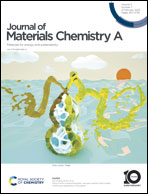Elemental doping inhibits surface-state-mediated charge carrier trapping for promoting photocatalytic selective oxidation†
Abstract
The surface-state-mediated trapping process, a dominant consumption pathway of photoinduced charge carriers, sometimes plays a detrimental role in gaining high-efficiency photocatalytic solar energy utilization. Herein, taking Bi2O2CO3 as a typical prototype, we highlight that vanadium doping could effectively inhibit surface-state-mediated charge carrier trapping in the system. According to spectral analyses and theoretical calculations, we attributed such an inhibition to the presence of shallow trap states close to band edges induced by vanadium doping. Compared with surface states, these vanadium-doping-induced states could trap photoinduced charge carriers, whereas their shallow feature facilitates charge carrier de-trapping. Benefiting from these characteristics, vanadium-doped Bi2O2CO3 (V-Bi2O2CO3) exhibits promoted performance in photocatalytic molecular oxygen activation and selective aerobic oxidation of organic compounds. This work provides an effective method for suppressing the detrimental charge-carrier-trapping mediated by surface states in semiconductor-based photocatalysis.

- This article is part of the themed collection: Photofunctional Materials and Transformations


 Please wait while we load your content...
Please wait while we load your content...